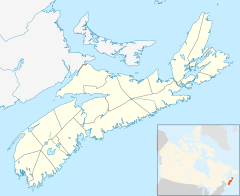Beaubassin facts for kids
Beaubassin was a very important Acadian village and trading spot. It was located on the Isthmus of Chignecto in what is now Nova Scotia, Canada. This area was key in the big power struggle between the British and French empires.
The village started in the 1670s on high ground near a large saltwater marsh. Settlers worked hard to turn the land into farms. They raised cattle and traded goods.
Contents
Building a French Colony
Beaubassin had strong connections with Port Royal. A farmer named Jacques Bourgeois sold some of his land there. He moved to the Chignecto Basin to build a flour mill and a saw mill.
Around the same time, Michel Leneuf de la Vallière de Beaubassin set up a fur-trading post. He also spent time fishing, farming, and soldiering. In 1676, Governor Frontenac gave him a large piece of land. This land became the Beaubassin seigneury, a type of estate. He settled on a high area called Île de la Vallière.
Life and Trade in Beaubassin
The settlement grew well on the rich Tantramar Marshes and nearby high ground. These lands were perfect for farming. The Isthmus of Chignecto was also a portage route. This meant people could carry boats and goods between the Bay of Fundy and the Northumberland Strait. This made Beaubassin a central hub for a huge trading network. It connected places like Île Royale, Nova Scotia, and New England.
The first fruit trees were brought from Port Royal by Roger Kuessey, an Irishman. He settled on a highland known as the Butte à Roger. In 1685, an official named Intendant Jacques de Meulles visited the site. He reported that the grasslands could feed thousands of cattle. There were 22 homes, most with many cattle, pigs, and sheep. However, not much land was used for growing crops.
In 1686, Beaubassin became a parish when Abbot Claude Trouvé built a church. The settlement eventually spread out. It reached areas like Mill Creek, Petitcodiac, Memramcook, and the Shepody Rivers.
By 1715, Beaubassin was home to about 50 families. They had 32 acres of apple orchards, 1,000 cattle, and 800 hogs. There was also a trading post. They traded with Louisbourg (in present-day Cape Breton) through Baie Verte. They also traded with New England through the Bay of Fundy.
By 1750, the population had grown to about 2,800 people. Other nearby villages included Weskak (now Westcock) and Aulac. About half of the people in Beaubassin were refugees. They had come from mainland Nova Scotia.
Early Conflicts and Attacks
Beaubassin faced attacks from New England forces. The first attack was in 1696 during Queen Anne's War. It was led by Benjamin Church. He returned in 1704 and attacked the Beaubassin region again.
The Destruction of Beaubassin
Beaubassin was in a very important military spot. Its peace ended due to the fight between Britain and France. Both wanted control of Canada in the mid-1700s.
Acadia included most of what is now the Maritimes. It also had parts of Quebec and northern Maine. In 1713, the Treaty of Utrecht was signed. This treaty made the part of Acadia known as peninsular Nova Scotia a British colony. However, the area now called New Brunswick stayed under French control. So did Prince Edward Island (then Île Saint-Jean) and Cape Breton Island (then Île Royale).
Disputed Borders and Forts
The treaty caused arguments about Acadia's exact borders. The ownership of New Brunswick was unclear. An unofficial dividing line was set on the Isthmus of Chignecto. It was at the Missiguash River, near Beaubassin.
In May 1750, the British sent Major Charles Lawrence. He had 800 soldiers. Their goal was to take control of the Isthmus of Chignecto. They planned to build a fort near the French post of Point Beauséjour. This would become Fort Beauséjour.
As the British arrived, the French and their allies burned Beaubassin. They did this to stop the British from using the town. Forty-five buildings were destroyed by fire. The Acadian people left the village. They found safety across the Missaguash River at Point Beauséjour. Major Lawrence and his troops later built Fort Lawrence near the burned site. The bell from Notre Dame d'Assumption Church was saved. It was later placed in a cathedral at Fort Beauséjour.
What Happened Next
The British taking control of the Isthmus of Chignecto was a big moment. It marked the beginning of the end for French power in Acadia. Less than five years later, British and New England troops used Fort Lawrence as their base. In June 1755, they captured Fort Beauséjour. Soon after, the Expulsion of the Acadians began. Many Acadians were forced to leave the area.
Beaubassin Today
In 2004, Parks Canada bought a large part of the land where Beaubassin once stood. In 2005, the site was named a National Historic Site of Canada. This site also includes the Fort Lawrence National Historic Site. There is a stone marker near the Nova Scotia visitor centre. It is off the Trans-Canada Highway in Amherst, Nova Scotia. This marker remembers the village.
The old fields of Beaubassin village hold many archaeological treasures. These include old glass and ceramic pieces. There are also remains of burned buildings. They show how the Acadians lived. Some modern buildings have affected the old sites. But much of the land is still farmland or marsh. Dips in the ground show where buildings once stood.
Population Growth
| Year | Number of inhabitants |
|---|---|
| 1671 | 127 |
| 1686 | 119 |
| 1693 | 174 |
| 1698 | ? |
| 1701 | 188 |
| 1703 | 246 |
| 1707 | 326 |
| 1714 | 345 |
| 1730 | 1,010 |
| 1737 | 1,816 |
| 1748 | 2,800 |



